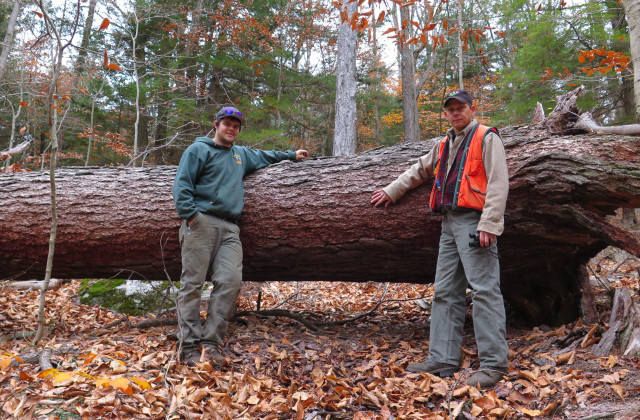It’s Only Natural
Lessons in a Hemlock Wood
by Hans M. Carlson
There is a palpable quietness to a grove of very old hemlock, a sense of grandeur that settles on you if you spend a little time beneath them. These stands are special places in Norfolk, and we have several on Great Mountain Forest (GMF). Some of these trees date to the early 17th century, and so were saplings when the Pilgrims landed at Plymouth. They were mature trees by the late 18th century, when Europeans arrived in the northwest corner.
It’s something of a mystery how these stands survived. This whole area was the heart of 19th century iron production, and much of the forest was cut to produce charcoal for local blast furnaces. There are old roads and colliers’ hearths within a quarter mile of most of our old-growth and, though hemlock was not good charcoal wood, there were tanneries in the area that used whole forests of hemlock bark to tan leather.
We will likely never know what saved these trees from that onslaught – maybe it was as simple as disputed ownership, but now, in 2015, the rather sad fact is that these stands are falling apart. Some are outwardly healthy, but in the last few years many of our oldest trees have been wind-thrown or their tops have snapped off. At 400-years-old, they have not yet reached their natural age limit, but there are new stresses affecting all the hemlock.
Last October, we spent a day monitoring hemlock with Carole Cheah, from the Connecticut State Agricultural Research Station, trying to judge the encroachment of hemlock wooly adelgid and elongate hemlock scale. We found no unaffected areas, even in the coldest hollows, and this was discouraging, though not unexpected. Hemlock makes up about 40 percent of GMF, as it does many other places locally, so we share everyone else’s concern. We are hoping that our elevation will buy us more time than other parts of the state, though there is no doubt about the long-term trend.
There is some good news. At Cheah’s monitoring site on Mountain Road, adelgid mortality was 96.4 percent this winter. Near the entrance to Haystack Mountain, it was 98.1 percent, and on the Appalachian Trail on Lion’s Head, it was 99.1 percent. The near-record cold winter has helped, but the northeast was an anomaly this year, as every other part of the country was warmer than normal. Statistically, winters are getting warmer, and the adelgid is a prolific breeder, so hemlock will eventually succumb.
Their absence will change everything in this forest. In terms of management, losing hemlocks will restart the process of regrowth that began more than a century ago with active conservation at GMF. This will mean a different ecology, a different aesthetic and a number of management decisions too – whether we cut hemlock or leave them, whether we replant something new in some places or wait for natural regeneration.
All this will shape the future forest, and so too will public understanding of our management practices here at GMF. The previous century of conservation was a private undertaking, funded by family money, but now that we are a non-profit, our continued stewardship is reliant on public support and interest. Public perception is of paramount concern for all non-profits, but here in the forest there will be significant ecological ramifications because support defines our ability to conserve and manage.
In a larger sense, human investment in the landscape is the norm in New England–in the past, and presently. After all, it was human choice to cut most of this forest in the 19th century, but spare those few stands of ancient hemlock. It was human choice to begin stewarding GMF in 1909, just as it was human choice in 1951 to import those first ornamental Asian hemlock to Virginia, along with the adelgid. Cultural and ecological contexts play off of one another here in our forests, and this is what’s most important as I think about the consequences of hemlock pathogens, or the future of GMF or simply enjoy the grandeur of ancient trees.
Photo by Carole Cheah. Forest Technician Wesley Gomez and Forester Russell Russ lean on one of the fallen giants by Bigelow Pond. This tree had a circumference of between eight and nine feet.

